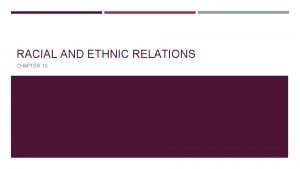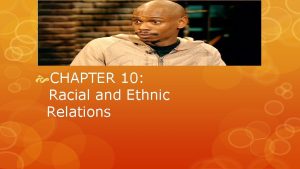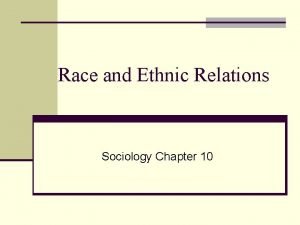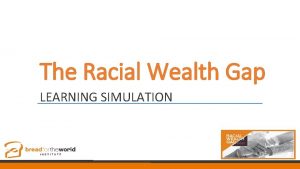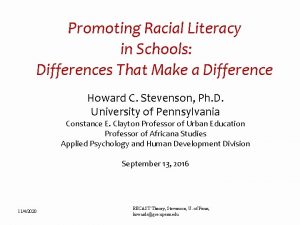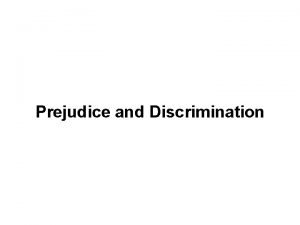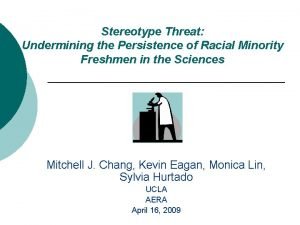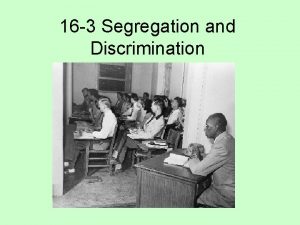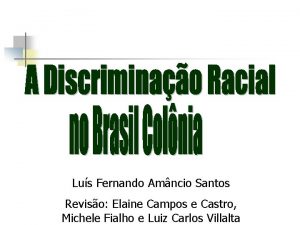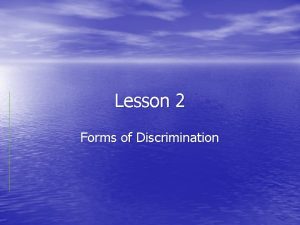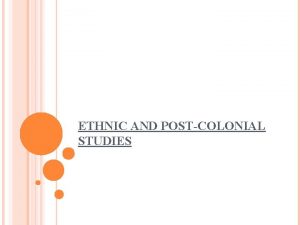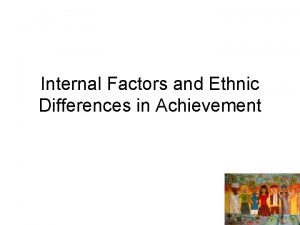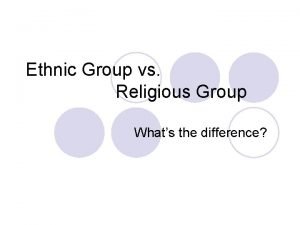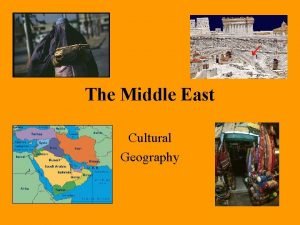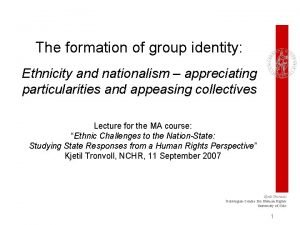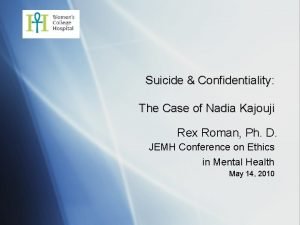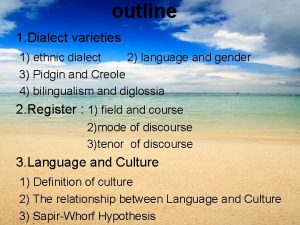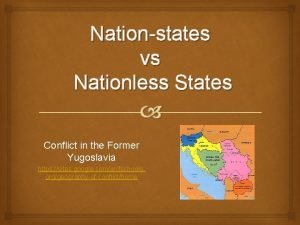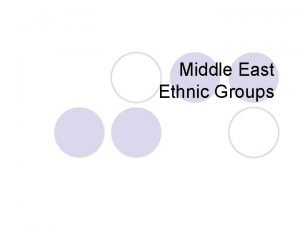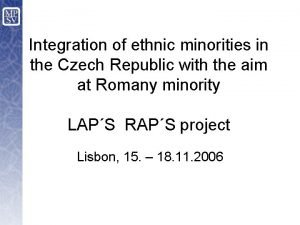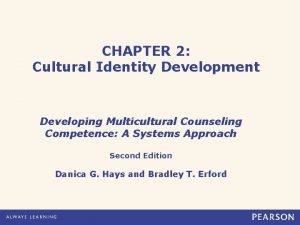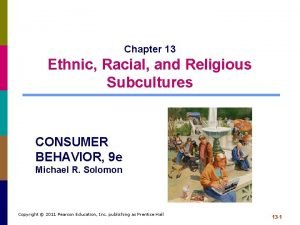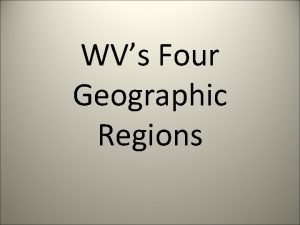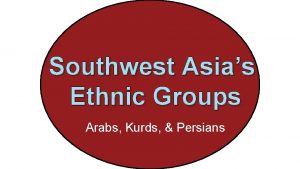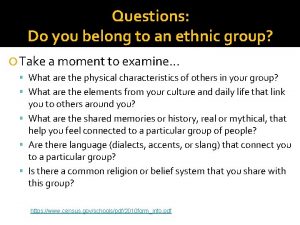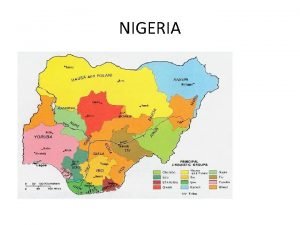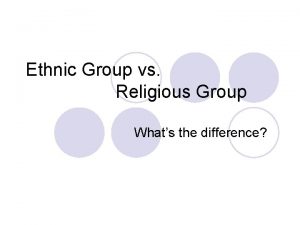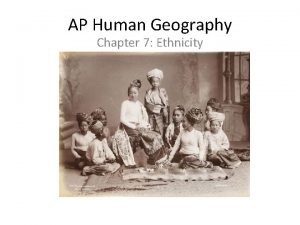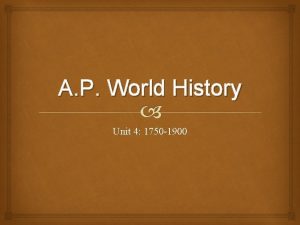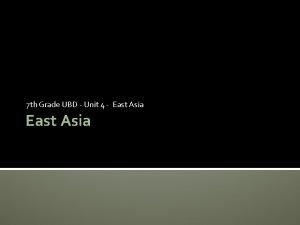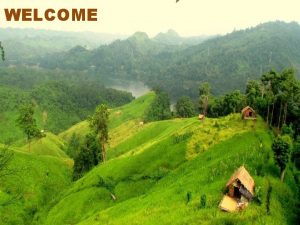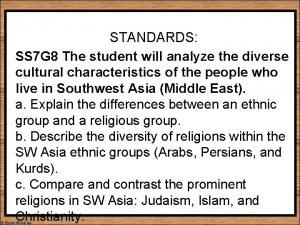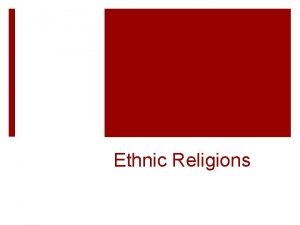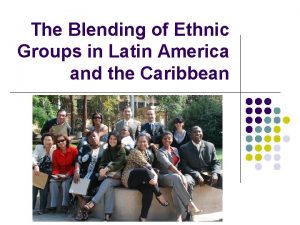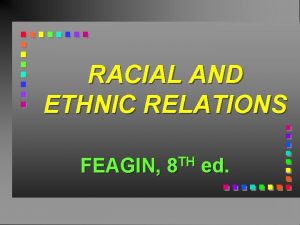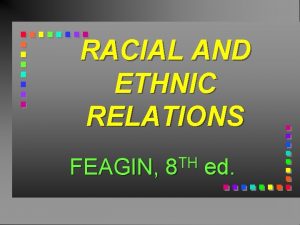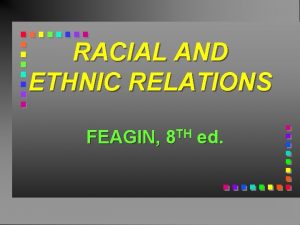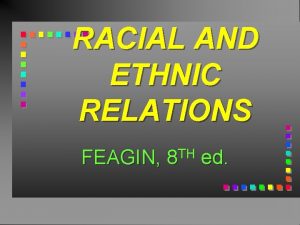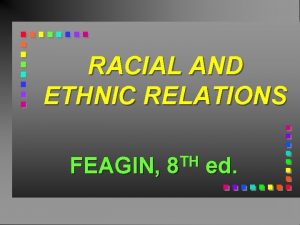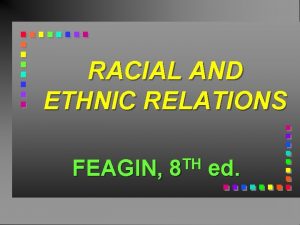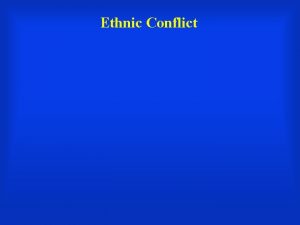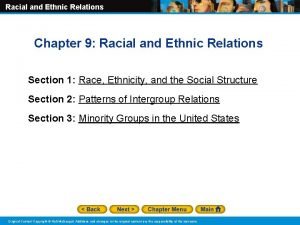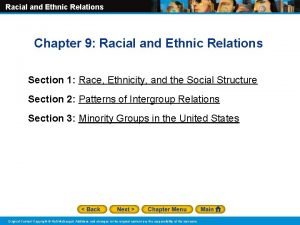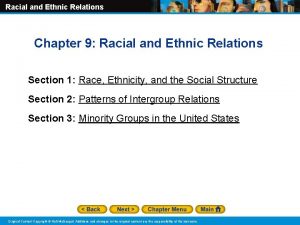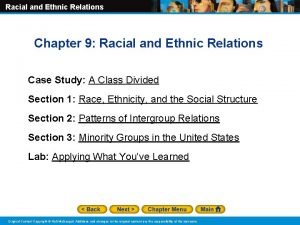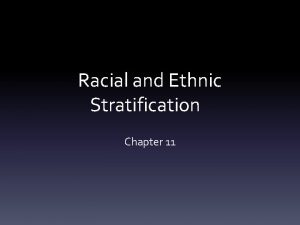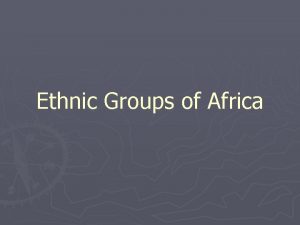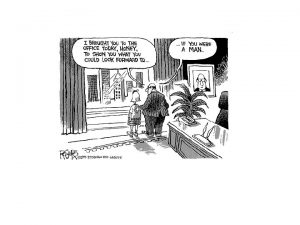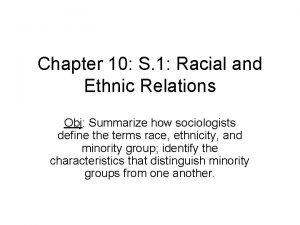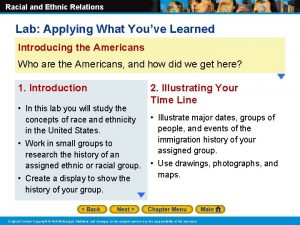RACIAL AND ETHNIC RELATIONS FEAGIN TH 8 ed

























































- Slides: 57

RACIAL AND ETHNIC RELATIONS FEAGIN, TH 8 ed.

NATIVE AMERICANS CHAPTER 6

• First victims of European colonization on this continent • • Called collectively and erroneously “Indians” by conquerors • • Indigenous people – hundreds of Native American groups Long suffered at the hands of white intruders European explorers latecomers • • • Continent already inhabited by millions Continent discovered 20, 000 years earlier Belief is they migrated across land bridge from Asia to Alaska

CONQUEST BY EUROPEANS • Human migration varies from voluntary to forced slave importation • Migration involves incorporation of new immigrant group into societal framework by dominant racial or ethnic group already established within certain geographical boundaries • • Process called colonization migration Colonization migration involves conquest and domination or preexisting geographical group by outsiders • Illustrates external colonization

• Analysts estimated indigenous population at about 1 million • Estimate has been revised upward to 15 million at time of conquest • • • Low figures used to legitimize European conquest of allegedly unoccupied land By 1890, combined effects of disease and violence reduced indigenous number to 250, 000 2000 Census • • • 2, 475, 956 people identified as American Indians 1, 082, 683 identified as white and Indian 182, 494 identified as black and Indian

• Most of more than 550 federally recognized Indian tribes have fewer than 10, 000 members • Five have populations greater than 100, 000 • • Cherokee, Navajo, Choctaw, Sioux, and Chippewa Only 36% live on reservations, on trust lands, or other Indian areas Most live in town and cities Number of Americans claiming Indian ancestry has increased • • Stigma of being part-Indian has declined Availability of government or tribal benefits

• Term “Indian” and government names for major Native groups given by whites • Not recorded under original names in history • • • Renaming result of racial subordination Suggests one major difference between colonized groups and European immigrants: • • Navaho call themselves Diné - “The People” Colonized people often have had little control over the group naming process Non-Indians think of Indians as single category • Have been diverse nations with major differences

• Early Cultural Borrowing Cultures of Native American societies more highly developed than European societies • • Had complex and sophisticated systems of government, community, economy, and communication 1 st decade of English settlement • • Numerous colonists deserted to Indian communities in search of better living conditions Matrilineal society • No social class, no state, little economic specialization

• The Colonial Period • White historians assert white settlers encountered hostile Indians • • European colonists slowly gained dominance • • • Indigenous Americans were the true settlers of continent Forcing Indians into frontier areas or killing them Few whites concerned about genocidal consequences of expansion Treaties, Reservations, and Genocide • • Indians viciously stereotyped and attacked in Declaration of Independence By action or inaction, federal officials supported theft of Indian lands

• Subordination supported by Andrew Jackson • • • Indian Removal Act (1830) • • • Slaveholding president critical of treaty making Encouraged states to defy Supreme Court rulings favoring Indians Voluntary or forced removal of Indians “Trail of Tears” – Large numbers died and faced serious survival problems in new lands Westward-moving whites precipitated struggles with Plains societies Often genocidal action of federal troops and white farmers a new experience for Indians Media presentations severely distorted reality of Plains wars

Myths About Conflict • Movies and television created unforgettable, often racist images of the West • John Unruh, et. al. • • Made clear that prevailing images are often mythical 250, 000 whites made journey across the plains to the West coast • • • Fewer than 2 in every 1000 died at the hands of Indians Between 1840 and 1860 total of only 362 whites and 426 Indians died in all the recorded battles along the wagon train route Recurring pattern in conflict between whites and Indians • • White farmers would move onto Indian lands and U. S. government would, by means of threat or coercion, resettle Indians Many treaties , still part of U. S. law, were masterpieces of fraud

• White Massacres of Native Americans • • Serious treaty violations by whites led to conflict After Civil War, with government support, large railroad corporations usurped land in the West • • Buffalo slaughtered in the millions and hunting economy of the Plains was destroyed Conflict over illegal white invasion escalated • Troops sent in to force Sioux onto smaller reservation • • Colonel George A. Custer; Little Big Horn, 1876 Most widely known battle of the Plains Custer and his soldiers wiped out by a Sioux group and its allies Wounded Knee Creek took place fourteen years later • • • Approximately 300 Indians killed while running from the camp Many old men, women, and children One of the last engagements

• In Southwest, Indian resistance was substantial • • Military expeditions against Navaho and Apache Captives herded on infamous “Long Walk” • • Central to Navaho collective memory of the oppression By 1890 most Native American groups forced into reservations • Even on reservations, groups attempted to maintain their cultures • • Language and religion Drew on their culture to resist pressure of acculturation to white folkways

RACIST IMAGES AND STEREOTYPES • After arrival of European colonizers • • Stereotypes of Indians as lazy and wild Europeans as hardworking and steady • • This, along with group classification by physical characteristics, served to distinguish colonizers from colonized “Child of Nature” or “Noble Savage” • European myth that was a mixture of appreciation and anti-Indian prejudice

• Violent resistance reinforced white stereotype of the “Indian savage” • • Image became common after battles in which Indians resisted Era of westward expansion imprinted on the white mind • Popular novels and later in films • • “Cruel Indian warriors attacking helpless white families” One erroneous image • “Primitive hunter” who made little use of the land • Indians were part-time or full-time farmers

• Paradoxical stereotypes also applied to women • A “princess” saves a white man from her own people; portrayed slightly darker with European features in books and movies • • • Disney “Squaw” -- the white man’s sexual partner; portrayed darker, fatter, cruder, with traits of drunkenness, stupidity, and thievery Research of textbooks in elementary, high school, and college found numerous stereotypes

• • Scholars criticize tendency of white observers to define Indians and their traditions in terms of 19 th century white images “Dances with Wolves”; “Last of the Mohicans” (1993) • • Feature white actors playing Indians to attract white audiences Pocahontas was 10 - to 12 -year-old child • Actual life included kidnapping and rape by whites; a trip to England, marriage to a white planter, and early death from disease

• • Only a few studies of white attitudes toward Native Americans Today, stereotypes are commonplace and have serious consequences • • • Lead to discrimination in policing, arrests, and sentencing by white officials Indians overrepresented in and receive harsher sentences compared with whites “Drunken Indian” stereotype is most extreme • Few Indians today have this problem • Only 5. 8% compared to 5. 1% of whites

• Contrary to popular images, the majority does not abuse alcohol • • Members of white hate groups carried out crimes against Indians • • Even though few societies have faced the cultural destruction and intensive racial oppression, past and present, that Native Americans have Developed websites circulating negative, vicious stereotypes CNN (1990) “Native Americans: the Invisible People” • • 1 st television network to detail historical and contemporary realities Owned by Ted Turner, also owner of Atlanta Braves • Supporters perpetuate negative stereotype

• CNN program and changes in textbooks • • Signal slow trend toward more honesty in dealing with U. S. history Recently, Native American writers, novelists, and moviemakers fight traditional racist images and portray more realistic images • Sherman Alexie, novel “Reservation Blues” and movie “Smoke Signals” • • Portray Indians in their own terms Characters struggle for self-definition and selfrepresentation against oppressive technological narratives

POLITICS Native American Cultures and Societies Before European Influence • Whites view Indians as not having civilization prior to European colonization • • • At initial contact most Indian societies as old and as developed as European ones Men and women had social respect and status Women played important social and political roles as men

• Cherokee and Iroquois matrilineal • • • Benjamin Franklin, Thomas Jefferson, and other leaders admired Indian democratic institutions • • Children belonged to mother’s clan, lived in mother’s family home, and inherited her property Among Iroquois, women chose tribal leadership and had significant political input American symbol, eagle clutching arrows, copied from Iroquois Whites wrote Native American history • Reason why important roles of women downplayed or ignored

• • The Politics of the European Invasion At first, colonizers dealt with Indians as independent nations As colonizers gained strength • • Treated nations as groups to be exterminated or dependent wards Bureau of Indian Affairs • • • Established to coordinate federal regulations with Indians Authoritarian supervision of reservations to provision of some supplies Traditional Indian leaders replaced by white leaders

• From the Dawes Act to the New Deal • 1887 Dawes Act • • • 1884 John Elk – Native American • • Provided that reservation lands be divided among individual families European tradition of private ownership and development of land an alien value system to Indians Supreme Court ruled not eligible to vote in Omaha, NE He was citizen of a foreign nation 1924, Congress passed Indian Citizenship Act 1934 Indian Reorganization Act (IRA) • • Intended to establish Indian civil and cultural rights Allow for semi-autonomous tribal governments and foster economic development on reservations

• • IRA ignored fundamental economic problems and maintained subordinate relationship of Indians to federal government Purpose of law was to finally and completely usurp the traditional mechanisms of Indian governance • • Replaced tribal chiefs and councils with system of federally approved and regulated councils Indians saw IRA as a violation of the sovereignty guaranteed by treaties • Law ratified by manipulation of the voting process

The Termination Policy • 1946 Indian Claims Commission • • • 1950 House Concurrent Resolution 108 • • Set up to deal with numerous claims on treaty violations and received numerous claims for compensation of land In first decade, most claims denied Called for termination of federal supervision of Indian groups 1960 s President Richard Nixon • Congress to maintain Indian’s close ties with federal government and prohibit any termination without consent

The controversial Role of the IRA • BIA defines who is an Indian by determining which tribal groups are officially acknowledged by government • Process emphasized by racial formation theorists • • Governments intrude into processes by which racial and ethnic groups are defined Growing numbers of Indians called for end to BIA control • Work for recognition as sovereign nations

• Indian Self-Determination and Education Assistance Act • • • Amended to enable several nations to plan for autonomous governance Furthered by U. S. Senate investigation revealing extreme BIA mismanagement 1996 Indian leaders filed lawsuit • • • On behalf of ½ million Indians seeking financial accounting and reform of government’s trust account system Resulted in Congress proposing Indian Trust Reform Act If passed would provide $8 billion as settlement to individual trust account holders and give some Indian control over trust assets on reservations

Growing Pressures for Political Participation • • • For Indians on reservations, political participation directed at reservation elections and service in tribal governments Indians running for political office increased Charles Curtis – born on Kaw Reservation in 1860 • Representative for 14 years, senator for twenty, and vice-president under Herbert Hoover

• Since 1935, only handful of Indians served in Congress • • • Ben Reifel (R-SD) 1961 -1971 Ben Nighthorse Campbell (R-Colo) 1992 Brad Carson Cherokee 2002 Thomas Cole (R-Okla) 2002 Chicksaw Number of Indian voters grown significantly over past decades Modest to slight representation paralleled in town and city governments • Few elected to city councils, school boards, or county governments

• Recent economic gains enable a few Indian groups to contribute significant amounts of money to political campaigns and fund lobbying in Washington, D. C. • • • Already helped stop passage of legislation detrimental to Indian interests Large majority of Indian groups not yet able to prosper economically and politically Over last decade, U. S. Supreme Court handed down series of major decisions that limit political and judicial power of reservation governments

PROTEST AND CONFLICT • • Organized Indian protest against subordination most sustained of any group in history of North America Indian Rights Association • • Founded by whites concerned with protecting and “civilizing” Indians Society of American Indians • 1 st formed by Native Americans • Goals included developing a national Indian leadership and improving educational and job opportunities

• American Indian Defense Association • John Collier (1920) • • NCAI (1940) • Largest advocacy group • • • Fight attempts by government officials to establish “executive order reservations” not covered by treaty and thus more accessible to exploitation by whites Pressed for education, legal aid, and progressive legislation Campaigned against stereotyping Over last few decades many Indian groups organized and pressed to relieve discrimination and oppression

Confrontation with the Federal Government • Red Power • • • Term that appeared during period of expanded Indian activism in 1960 s Engaged in civil disobedience American Indian Movement (AIM) • • Organized to address problems ranging from police brutality to discrimination in housing and employment Organized occupation of Wounded Knee, S. D. • In attempts to convict AIM, government used police-state tactics and case was dismissed

Leonard Peltier: A U. S. Political Prisoner • Recent Indian protests seek to free Peltier, a Lakota Sioux Indian • • Accused of shooting two FBI agents at confrontation in Pine Ridge Reservation, 1975 Unclear who shot agents and Congress supported new trial for Peltier Revelations that FBI withheld documents from defense attorneys added support to international call for his freedom Global protest and legal efforts to free him continue to this day

Anti-Indian Racism and Sports Mascots • • AIM and other groups protest use of Indian names, sacred symbols, and gestures by white-oriented sports teams Redskins, Chiefs, and Braves with associated caricatures involve offensive anti-Indian images and stereotypes National Coalition on Racism in Sports and the Media joined protesters Today, colleges and universities still use Indian logos

• Mascots and related fan actions often based on stereotypes of Indians as wild “savages” or blood-thirsty warriors • • Ignore historical reality of savage European takeovers of Indian lands and genocidal policies U. S. Census Bureau decided not to include pictures of sports teams that still used stereotyped Indian images • • 2001, U. S. Commission on Civil Rights 2005 National Collegiate Athletic Association (NCAA) • Joined in condemnation of stereotyping in sports

• • Honoring Treaties: Fishing Rights and Land Claims Provoked conflict between Indians and whites in several states U. S. v. State of Washington (1974) • • Ruled that indigenous rights reserved by treaties are different from those allowed whites In recent decades, many groups pressed land claims in court • • Oneida and Mohawks in New York Lakota Sioux

THE ECONOMY • Manifest Destiny • • Economic exploitation accompanied growth of industrial capitalism and urbanization • • The U. S. had a right to expand from the Atlantic Ocean to the Pacific and would inevitably do so Encroachment on Indian lands fueled growth in cities Poverty of reservations rooted in destruction of local economies and mismanagement by BIA officials

• Council of Energy Resources Tribes (1970 s) • • With urban migration farm occupations dropped • • Provide technical and financial assistance to help member groups control their energy resources Urban workers concentrated in secondary labor market characterized by job instability, low wages, little mobility, and disproportionately non -white Indians less likely than U. S. workers as a group to hold managerial or professional positions

These census data are for those who reported only Indian ancestry.

Source: Office of Personnel Management, www. opm. gov Native American civilian employees in the executive branch of the federal government are the most heavily represented in clerical, technical, and blue -collar job categories. Their percentage is lowest for professional positions. The percentage of Native American workers is highest at the lower pay levels and lowest at the highest pay levels.

• • • Prevailing ideas about poor Indians are full of myths that keep our racist, oppressive system in place For decades Indians have had lowest median family income and per-capita income of any major racial or ethnic umbrella group Part of economic improvement in recent decades may be an effect of large increase in people self identifying as Indian

• Growing self-determination movement and recognition of tribal sovereignty in courts • • • Dozens of Indian nations developed gambling and other enterprises in attempts to improve local economies Profits from gaming constituted first regular income for some groups Over recent decades, Mississippi Band of the Choctaw Nation and Cherokee Nation Industries • Successful in developing industrial parks that have attracted Fortune 500 companies

• White investors, lenders, and management firms claimed large share of revenues from many Indian gambling operations • • Federal investigation found many tribes to be victims of economic exploitation and embezzlement by white firms Certain economic opportunities rejected • Landfill space for outside garbage or nuclear waste • Indian land attractive because of low population density and not generally subject to state environmental regulations and taxes

EDUCATION • Influential whites supported education as forced channel to acculturation • • • Enforced acculturation recurring issue in BIA and public schools Organized protest since 1960 s led to expansion of government aid for primary adult and vocational education Movement of many to cities resulted in decline of children in BIA schools • U. S. Department of Education Task Force • Local and federal education systems have failed to meet the needs of Indian students

• • Indian educational attainment levels below those of general population American Civil Liberties Union (ACLU) • • Documented discriminatory treatment of Indian students by white personnel and recurring harassment by white students Nonetheless, Indian youth attended and graduated from two and four-year colleges in larger numbers • Most attend predominantly white colleges; several thousand attended the 33 Indiancontrolled colleges

• • • RELIGION Indian groups periodically pressure museums and other facilities to return religious and art objects, many of which were obtained illegally Protested display of Indian skeletal remains in museums and have called for return for proper burial ceremonies Pressure to adapt to American culture clear in case of religion • White conquerors often tried to convert “heathen Indians” to Christianity • Only minority identify with Christianity

• Millenarian Movements • • Peyote Rituals • • Often led by visionaries, oriented to a “golden age” in which supernatural events will change oppressive conditions New religion that spread through Plains between 1880 and 1900 Reflected ambivalence toward Christianity Accepted as distinctive Christian group in 1918 Most traditional religious beliefs and practices of Indians are not exclusive • Person can be Christian and traditional believer

Indigenous Americans Overseas • U. S. has significant colonies overseas • Indigenous groups on Caribbean and Pacific Islands brought under U. S. politicaleconomic control • • Supervised and controlled by U. S. Department of the Interior with no voting representation in Congress Puerto Rico (commonwealth) and Virgin Islands (unincorporated U. S. territory) • Caribbean

• Six colonial jurisdictions in the Pacific • • Mariana Islands Guam and American Samoa Federated states of Micronesia Republic of Marshall Islands Republic of Palau U. S. Pacific Islanders include indigenous people of Hawaii Colonized Americans have high poverty level and lower median family income than continental U. S. Worse disease and mortality rates than U. S. population as a whole

ASSIMILATION AND COLONIALISM • • • Opportunity to assimilate more open for Indians than other people of color Assimilation model focuses on extent to which traditional Indian cultures have undergone Europeanization Living patterns and sense of Indian identity vary widely today • Sioux and Navaho have strong group identity, while others lost their old ways and group identities

• Intensive, often forced, acculturation have failed to destroy indigenous cultures • • Structural integration other than low paying jobs in economy has come slowly for Indians • • Evident in persistence of traditional Indian languages Movement into economic mainstream did not begin until urban migration Social integration at primary level with white families have come slowly, especially for those on reservations

• Adaptation occurred on other dimensions of assimilation • • Attitude-receptional, behavioral-receptional, and identificational assimilation Attachment to ancestral identity strong among those who have predominantly Indian ancestry • Number of organizations have tried to build a “pan-Indian identity” and promote unity among Indian groups

• • • Recent research shows that over last few decades Indians in major metropolitan areas have experienced a degree of spatial assimilation When Indians move from reservation to cities to tribal cultures weaken as part of urbanization process Social scientist theorize argue that power conflict model relevant to Indian experience • Accents deception, genocide, and land theft that was part of subordination process

• Power-conflict analysis stresses the reality of forced acculturation and incorporation processes • • At all educational levels, Indian children face great one-way acculturation pressures • • Frequently accents the one-way character of social adaptation pressures Most capitulate to some degree, some adopting white stereotypes of Indians, and some behaving in white-preferred ways Colonialism analysts stress that many remain isolated politically and geographically

• • Many Indians are fighting against American oppression Power-conflict emphasizes importance of struggle against white pressures and continuing racial oppression
 Timid bigot example
Timid bigot example Chapter 10 racial and ethnic relations
Chapter 10 racial and ethnic relations Chapter 10 racial and ethnic relations review worksheet
Chapter 10 racial and ethnic relations review worksheet Feagin mill middle school
Feagin mill middle school Black studies and the racial mountain
Black studies and the racial mountain Employee relations in public relations
Employee relations in public relations Racial etiquette targets
Racial etiquette targets Racial wealth gap simulation
Racial wealth gap simulation Promoting racial literacy in schools
Promoting racial literacy in schools Frederick jackson turner thesis apush
Frederick jackson turner thesis apush Racial prejudice
Racial prejudice Symbolism of noli me tangere
Symbolism of noli me tangere Racial insults
Racial insults In what region did racial etiquette exist
In what region did racial etiquette exist Cartel ley organica contra la discriminacion racial
Cartel ley organica contra la discriminacion racial Democracia racial
Democracia racial Lesson 2 discrimination
Lesson 2 discrimination Ethnicity in postcolonial literature
Ethnicity in postcolonial literature Ethnocentric curriculum
Ethnocentric curriculum What's the difference between ethnic and religious group
What's the difference between ethnic and religious group How are ethnic groups and religious groups related
How are ethnic groups and religious groups related Islam universalizing or ethnic
Islam universalizing or ethnic Ethnic groups in the middle east
Ethnic groups in the middle east Ethnic boundary marker
Ethnic boundary marker Nadia kajouj
Nadia kajouj Madrid spain absolute location
Madrid spain absolute location Taliban vs western values ap human geography
Taliban vs western values ap human geography Religion
Religion Ethnic formation
Ethnic formation Ethnic dialect
Ethnic dialect Nation vs state
Nation vs state Ethnic groups in the middle east
Ethnic groups in the middle east Ethnic groups cloze notes 1 answer key
Ethnic groups cloze notes 1 answer key Ethnic groups in czech republic
Ethnic groups in czech republic Ethnic religion
Ethnic religion Cultural identity development models
Cultural identity development models Ethnic subcultures
Ethnic subcultures An anthropologist looks at ballet
An anthropologist looks at ballet Write 5 ethnic groups you know in panama en español
Write 5 ethnic groups you know in panama en español Potomac section ethnic groups
Potomac section ethnic groups Kaaba location
Kaaba location Which ethnic group do you belong to
Which ethnic group do you belong to Lute hole
Lute hole What are the 250 ethnic groups in nigeria
What are the 250 ethnic groups in nigeria Divine masculine
Divine masculine Acculturation
Acculturation Whats ethnic group
Whats ethnic group Ethnic groups
Ethnic groups Ethnic hash answers
Ethnic hash answers Blockbusting ap human geography
Blockbusting ap human geography An anthropologist looks at ballet
An anthropologist looks at ballet Manifest destiny era
Manifest destiny era Whats ethnic group
Whats ethnic group Foyme
Foyme Ethnic groups cloze notes 1
Ethnic groups cloze notes 1 Ethnic groups coat of arms
Ethnic groups coat of arms Subgroups of hinduism
Subgroups of hinduism Ethnic blending
Ethnic blending
